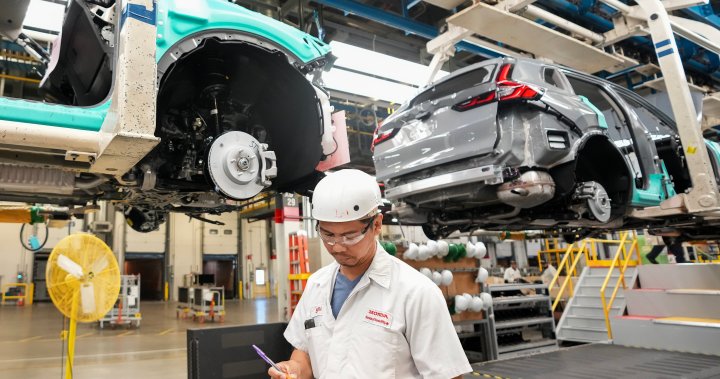
The federal and Ontario governments are set to make “an important automotive announcement” which is expected to be that Canada’s first lithium ion separator plant will be built in Port Colborne, Ont.
As first reported by iPolitics, Japanese company Asahi Kasei said on April 25 that it will build a lithium ion separator plant — a first of its kind facility — in Ontario. That was the same day that Honda announced its $15-billion plans for an Ontario electric vehicle supply chain.
According to Asahi Kasei, this plant will cost nearly $1.6 billion and produce 700 square metres of a specially coated membrane used in lithium battery manufacturing annually. Asahi Kasei did not mention which municipality the plant would be coming to in its April announcement.
A senior government source confirmed to Global News that Tuesday’s announcement is that Canada’s first lithium ion separator battery plant will be built in Port Colborne.
At the time of Honda’s announcement last month, the company said it would retrofit its existing vehicle plant in Alliston, Ont., to build solely electric vehicles, a battery plant nearby, and two battery part facilities elsewhere in Ontario.
The Niagara region plant is part of the two levels of government partnering with Japanese auto-maker Honda to build an entire electric vehicle supply chain in Canada.
Unlike previous electric vehicle deals inked by Ottawa and Ontario, this one does not appear to include production subsidies.
Instead, the federal government is contributing $2.5 billion through tax credits under the already existing clean technology manufacturing program and proposed electric vehicle supply chain tax credit included in the 2024 budget.
Ontario is contributing $2.5 billion through direct help on capital costs and indirectly through covering the land servicing costs for the future facilities.
The federal and Ontario governments have already put up a combined $28.2 billion in subsidies to attract battery plants from Volkswagen and Stellantis LG to St. Thomas and Windsor, respectively. This tactic was used to attract the plants to Canada instead of the United States, which included incentives in the Inflation Reduction Act.
These subsidies are contingent on hitting hiring, construction and production targets, which are expected to be doled out over the years, ending in 2032.
The federal government is covering two-thirds of these costs, with the Ontario government paying for the remainder.
Currently, the federal government’s goal is to have all new vehicles sold in the country be electric by 2035.
The announcement comes as the Biden administration has announced plans to slap new tariffs on Chinese electric vehicles, advanced batteries, solar cells, steel, aluminum and medical equipment — an election-year move that’s likely to increase friction between the world’s two largest economies.
The tariffs come in the middle of a heated campaign between President Joe Biden and his Republican predecessor, Donald Trump, in which both candidates are vying to show who is tougher on China.
The tariffs are unlikely to have much of an inflationary impact because of how they’re structured, administration officials said. They explained they think the tariffs won’t escalate tensions with China, yet they expect that China will explore ways to respond to the new taxes on their products. It’s uncertain what the long-term impact on prices could be if the tariffs contribute to a wider trade dispute.
The tariffs are to be phased in over the next three years, with those that take effect in 2024 covering EVs, solar cells, syringes, needles, steel and aluminum and more. There are currently very few EVs from China in the U.S., but officials worry that low-priced models made possible by Chinese government subsidies could soon start flooding the U.S. market.







